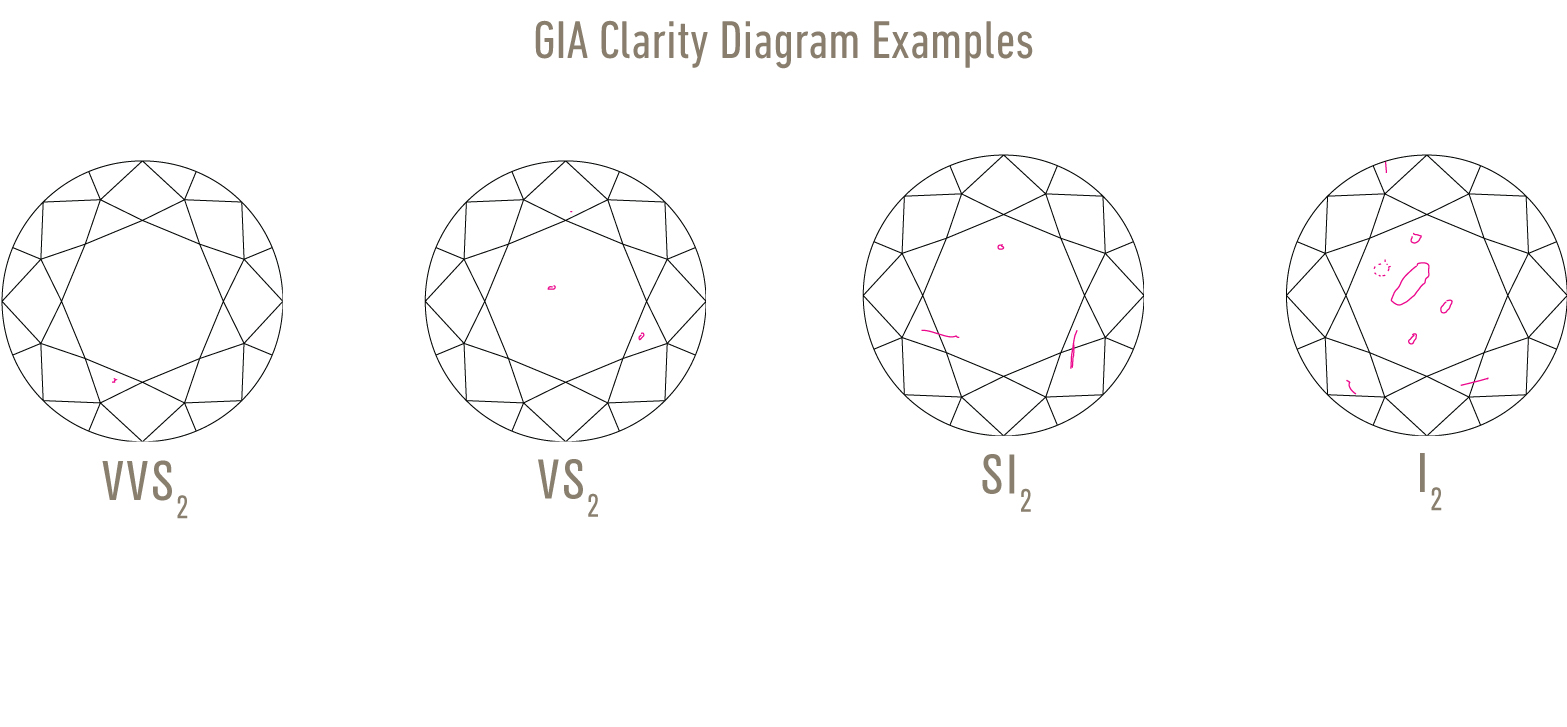DIAMOND EDUCATION
4C's
Diamond Color, Clarity, Cut and Carat Weight are collectively termed the 4Cs – the factors that, when combined,define a diamond’s quality and ultimately determine its value. GIA created the 4Cs of Diamond Quality, which hasbecome the universal method for assessing the quality of any diamond, anywhere in the world. The creation ofthe 4Cs means that diamond quality can be communicated in a universal language so diamond purchasers knowexactly what they are buying.
Carat Weight
Diamond weight is measured in carats. One carat is equal to 0.2 gram, about as heavy as a paperclip. Since larger diamonds are more rare, they will cost more than a smaller gem with the same color, clarity and cut grades

Color
GIA’s diamond color grading system measures the absence of color, starting with D as colorless and continuingto Z representing light yellow or brown. The distinctions between color grades are so subtle that they are often invisible to the untrained eye but can make a big difference in diamond quality and price.

Clarity
Natural diamonds form from carbon exposed to tremendous heat and pressure deep in the earth. Diamonds often contain clarity characteristics, called inclusions or blemishes. Inclusions are enclosed within the gem and blemishes are on the surface of the diamond. If all else is equal, the closer a diamond is to flawless, with no inclusions or blemishes, the higher its value.


Cut
A diamond’s cut determines its sparkle. To fashion a stone with proportions, symmetry and polish worthy of an excellent cut grade requires artistry and workmanship. The finer the cut quality, the more sparkle the diamond has.

Inclusions
Natural diamonds are the result of carbon exposed to tremendous heat and pressure deep in the earth. This process can result in a variety of internal characteristics called ‘inclusions.’ Many inclusions and blemishes are too tiny to be seen by anyone other than a trained diamond grader. This is why expert and accurate assessment of diamond clarity is extremely important.
Flawless (FL): No inclusions and no blemishes are visible to a skilled grader using 10x magnification
Internally Flawless (IF): No inclusions and only blemishes are visible to a skilled grader using 10x magnification
Very, Very Slightly Included (VVS)Very, Very Slightly Included (VVS): Minute inclusions that range from extremely difficult to very difficult to see arevisible to a skilled grader using 10x magnification
Very Slightly Included (VS)Very Slightly Included (VS): Minor Inclusions that range from difficult to somewhat easy to see are visible to a skilled grader using 10x magnification
Slightly Included (SI): Noticeable inclusions that range from easy to very easy to see are visible to a skilled grader using 10x magnification.
Included (I): Obvious inclusions are visible to a skilled grader using 10x magnification and may affect transparency and brilliance.
GIA Grading Report
The GIA Diamond Grading Report includes an assessment of a diamond’s 4Cs – Color, Clarity, Cut and Carat Weight – along with a plotted diagram of its clarity characteristics and a graphic representation of the diamond’s proportions. The GIA Diamond Dossier® includes these without the graphical representation of the clarity characteristics. The GIA laboratory issues diamond grading reports for loose, natural diamonds in the D-to-Z color range that weigh 0.15 carats or more.
Why ask for a grading report?
A diamond grading report is the scientific blueprint of a stone’s quality characteristics. A GIA diamond grading report is your assurance that your diamond is a natural diamond, with disclosure of any treatment to enhance color or clarity. The report provides the clear evidence that is vital to a confident purchase. A GIA Diamond Grading Report not only provides expert analysis of Color, Cut, Clarity and Carat Weight, it also contains a plotting diagram that clearly shows a diamond’s inclusions and clarity characteristics. The GIA Diamond Dossier® includes these without the graphical representation of the clarity characteristics. All GIA reports contain security features to prevent them from being forged or duplicated. GIA does not buy or sell diamonds, making an independent diamond grading report from GIA an unbiased assessment of the diamond.
Diamond Fluorescence
Fluorescence is the visible light some diamonds emit when they are exposed to invisible ultraviolet (UV) rays. On a GIA diamond grading report, fluorescence refers to the strength, or intensity, of the diamond’s reaction to longwave UV, which is an essential component of daylight. The light emitted lasts as long as the diamond is exposed to the ultraviolet source.
Diamond Treatments
While treatments can improve a stone’s Color or Clarity, the presence of such enhancements may affect the diamond’s value – particularly if the price reflects its appearance after treatment. Buyers have a right to know whether a stone is natural, a diamond simulant or a diamond created in a lab, and whether or not the stone has been treated to enhance its appearance.
Diamond Simulants
While the appearance of diamond simulants is similar to that of natural diamonds, they are not diamonds. Common diamond simulants include glass and cubic zirconia (CZ), both of which are completely unrelated to diamond at the atomic level. Simulants are generally less expensive than the real thing. They allow consumers to enjoy the flash and dazzle of diamond-like jewelry and to inexpensively complement the latest fashion trend. But no matter how convincing the illusion, all diamond simulants have optical and physical characteristics that can be identified by a trained gemologist.
Laboratory-grown diamonds
A lab-grown diamond (sometimes called man-made or synthetic diamond) is the result of a technological process, as opposed to the geological process that creates natural diamonds. Lab-grown diamonds have essentially the same chemical composition, crystal structure, optical and physical properties of diamonds found in nature. Most lab-grown diamonds are categorized as either high-pressure, high-temperature (HPHT) or chemical vapor deposition (CVD) diamonds, depending on the method of their production. Since HPHT and CVD diamonds grown in a laboratory are virtually identical to natural diamonds, differences only become clear when they are analyzed in a gem laboratory.
How to care for your diamond
Diamonds are remarkably durable, resist scratching (except by other diamonds) and maintain their brilliance over time. But diamonds aren’t indestructible. They can be chipped by a sharp blow, become loose or lost in a weakened setting, or be damaged by contact with other diamonds. Wear diamond jewelry with care. Store it in padded boxes or soft bags separate from other jewelry. Clean your jewelry by wiping it with a lint-free cloth or with warm water, mild soap and a soft toothbrush, or by dipping it briefly in a commercial cleaning solution. Have your diamond jewelry periodically cleaned and its setting examined by a professional jeweler to maintain its beauty and integrity over time.
About GIA
Established in 1931, GIA protects the public through gemological research, education, impartial gem identification and grading services, and instrument development. The world’s foremost authority in gemology, GIA sets the global standard for determining the quality of diamonds and performs research-based identification of colored gems and pearls. GIA created the 4Cs of diamond quality and the International Diamond Grading System™, providing all who buy or sell gemstones with a common language for describing diamond quality. As an independent nonprofit organization, all of GIA’s activities are governed by its mission to serve the public.
